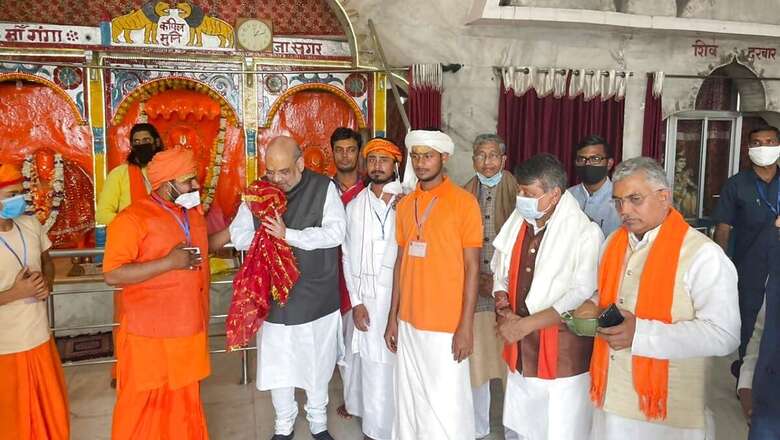
views
The singularities of caste and Hindutva are combining with Bengali identity in the electoral game of West Bengal. The BJP is weaving its poll discourse around this. In a way, Bengal’s politics is taking inspiration from the politics of the Hindi belt. The decade of the 1990s, which started with the introduction of a neoliberal economy in India, also saw the enormous rise of identity discourse in north Indian politics, such as the proliferation of politics around caste identities and the growth of Hindutva identity-based politics. Bengal had so far restrained itself from being pushed onto these lines. But the BJP has added these identity-based wheels to its electoral chariot for the coming assembly elections in the state. So, one may observe that Bengal is going through a big transformation in the language of its politics.
Due to this transformation, BJP Bengal unit president Dilip Ghosh is being perceived by a section of people of rural Bengal as an OBC leader. The whispering around dispossession of upper-caste dominance by such OBC-Dalit assertion in this election can be heard in some parts of the state’s backwoods. However, it has not yet claimed a place in mainstream public discourse and is flowing latently in ‘jan varta’ (public talk) here and there.
These ‘chai-paan’ (tea and betel) shop discussions in rural Bengal during election time made us realise that the form and craft of public conversations in OBC-Dalit dominant zones of rural Bengal developed similar Dalit-Bahujan discourse as Hindi-speaking regions, such as Uttar Pradesh and Bihar. It is difficult to confirm at the moment, but if it is going to emerge as a form of future OBC-Dalit discourse of Bengal, it may be cohesively combined with Hindutva identity which the BJP is forging. It is almost clear that it is not going to evolve as it appeared in Dalit-Bahujan discourse led by Kanshi Ram-Mayawati or Chandrashekhar Azad in Uttar Pradesh. So, the recent turn of Bengal’s political discourse is similar as well as different from the modes of the political discourse of the Hindi belt in some sense.
The RSS-BJP combine was working for many years among the OBC-Dalits and tribal communities in Bengal and preparing them for their political assertion. The OBC communities constitute around 17 per cent and Scheduled Caste communities are around 23 per cent of Bengal’s population. The Scheduled Tribe population is around 5.5 per cent. So, together these social groups constitute a large vote bank in Bengal like many other states of India. If the Hindutva movement succeeds in making these social communities assertive and evolves them as its political base in Bengal, it may break its stereotypical image of an upper-caste centred movement, at least in this state. In places like Uttar Pradesh and Bihar, the BJP succeeded in making a dent in OBC and SC communities, but its leadership at various levels in these states is still dominated by upper castes. In Bengal, its emergence is recent and it started with OBC faces such as Dilip Ghosh; so this may help the BJP to come out of its familiar image of a ‘party of upper caste dominance’. One of the favourable conditions of the rise of saffron Dalit-Bahujan politics in Bengal is that Ambedkarite radical Dalit-Bahujan is almost insignificant here who could impede the inclusion of marginal communities in Hindutva.
Even though the Dalit-Bahujan assertion in Bengal is going to represent itself through the Hindutva way, it may evolve with the dominance of numerically powerful castes among Dalits such as Namasudras and Rajbongshis. These two castes have acquired a fair amount of visibility in the ongoing electoral discourse of Bengal. They have taken up a central position even in the Hindutva-led political narrative. These two castes had the capacity to assert themselves politically during colonial times. But their political assertions were appropriated by the ‘Bhadralok’ and Leftist political conversation of Bengal, and they have dominated it for a long time. It seems other numerically smaller Dalit castes such as Bagdi, Pod, Bauri, Chamar, Hari, Dhoba, Jalia Kaibarta and many others in Bengal may remain invisible for some more time as it happened in the Dalit-Bahujan discourse of the Hindi-speaking states like Uttar Pradesh and Bihar.
So, electoral democracy in India works with its own logic and delivers political empowerment first of all to those communities who are numerically strong and have acquired the capacity to assert themselves earlier than others. Due to this, categories like Ati-Dalit, Mahadalit, and most-marginal emerged in our vocabulary of democracy and governance. The equal production and distribution of capability of representation among Dalit-Bahujan communities may stop further production of inequalities in society. It is yet to be seen what the Hindutva-led Dalit-Bahujan political assertion in Bengal leads to.
(Badri Narayan is professor and director of GB Pant Social Science Institute, Prayagraj, and the author of ‘Republic of Hindutva’. Views expressed are personal)
Read all the Latest News, Breaking News and Coronavirus News here
















Comments
0 comment